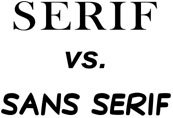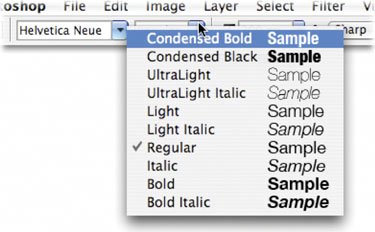Choosing Fonts
| Font choice is a very tough decision for a lot of new designers. You are likely overwhelmed with a landslide of options. To simplify the process, approach it with a triage mentality:
While these are my three simple rules, there are other constraints at play... It's a good idea to formally study typography if you want to work in this field professionally. At the bare minimum, you can at least read a few books. I strongly recommend The Mac Is Not a Typewriter (Peachpit Press, 2003) by Robin Williams and Stop Stealing Sheep & Find Out How Type Works (Adobe Press, 2002) by Erik Spiekermann and E.M. Ginger. But since we are here together, let's get the essentials down, together.  Serif vs. Sans SerifWhile there are many characteristics to a font, the presence or lack of serifs is one of the easiest to identify. Serifs are the hooks that distinguish the details of letter shape. Sans serif fonts tend to be more uniform in shape. Choosing which type of font to use will depend greatly on your needs. Table 12.1 shows the pros and cons of serif versus sans serif fonts.
X-height, Ascenders, and Descenders You'll quickly notice that point size for fonts is a very relative measurement. The apparent size of your text will depend on which font you choose and what resolution your document is set to. Most designers will look at the height of a lowercase x when deciding which font to use. This is because a lowercase x is a very clean letter with a distinct top and bottom. By comparing the x characters, you can quickly compare and contrast fonts. This measurement is combined with ascenders (strokes that go above the top of the x) and descenders (strokes that go below the bottom of the x, or the baseline). These three aspects will provide a visual clue to the font's purposes. Heavily stylized fonts (such as those used for titles or logos) will often have greater variety than those intended for a newspaper layout, where the text must take up little space, yet remain easy to read. Font Weight/Font FamiliesIf a font comes in several weights (such as bold, condensed, book, italic), it offers increased flexibility. These different versions of a font are called a font family. When choosing a font to use in a design, pros often look to font families. Some of the best designs use a single font family, but mix weights. This allows a consistent look, but with the added benefit of consistent style throughout. You'll find font families listed next to the font name in both the Options bar and the Character palette. |
EAN: 2147483647
Pages: 129




